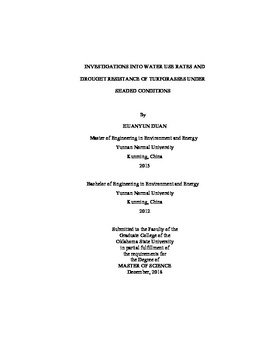| dc.description.abstract | Bermudagrass (Cynodon spp.) is the primary of turfgrass species used for residential lawns in Oklahoma. In place of bermudagrass, tall fescue [Schedonorus arundinaceus (Schreb.) Dumort., nom. cons.] has often been planted in shaded environments. Zoysiagrass (Zoysia Willd.) is a lesser-used turfgrass species that is well-adapted to Oklahoma and could potentially serve as an alternative choice in shaded environments. A one-year field study was conducted in summer 2018 to test the water use rates and turf performance of zoysiagrass including 11 cultivars of zoysiagrass and 1 cultivar of bermudagrass. Grasses were evaluated under 73% shade and open sun. In terms of turf quality, 'Diamond' and 'Meyer' were the top two performers in severe shade, and Celebration was the worst performing cultivar. Additionally, the microclimate coefficient of the top performers and Celebration suggested that bermudagrass respond to shade environment differently than zoysiagrass but there was also variation between cultivars among zoysiagrass. | |
| dc.description.abstract | In addition, one greenhouse experiment tested the hypothesis that turfgrass vary in their morphological response to shade and these changes may result in cultivar-specific changes in water use rates in response to shade. 'Shade' (55% shade) and 'Non-shade' (12-hour supplemental lights) treatments were applied using a neutral black shade fabric on 'Falcon IV', 'Meyer', 'El Toro', and 'Latitude 36'. Irrigation was applied manually being well-watered (100% ET), and data collected included NDVI, Chl, LA, SLA, CY, LER, and evapotranspiration rate. The ET rate of Falcon, Meyer, El Toro, and Latitude 36 reduced under shade by 13%, 23%, 24%, and 29%, respectively. Further, the other measured variables responses were inconsistent and not clearly related to water use rate or shade tolerance. Followed with another study to test the hypothesis that shade will enhance turfgrass drought resistance under progressive soil drying. Within the same shade and non-shade environment, plants were subjected to either daily replacement of evapotranspiration or no irrigation. Plants were evaluated for relative water content, leaf firing, ET rate, and dry roots mass. Results suggested that shade had no effect on the transpiration break point for Falcon IV, Meyer, and El Toro, but the break point of Latitude 36 was delayed. | |
